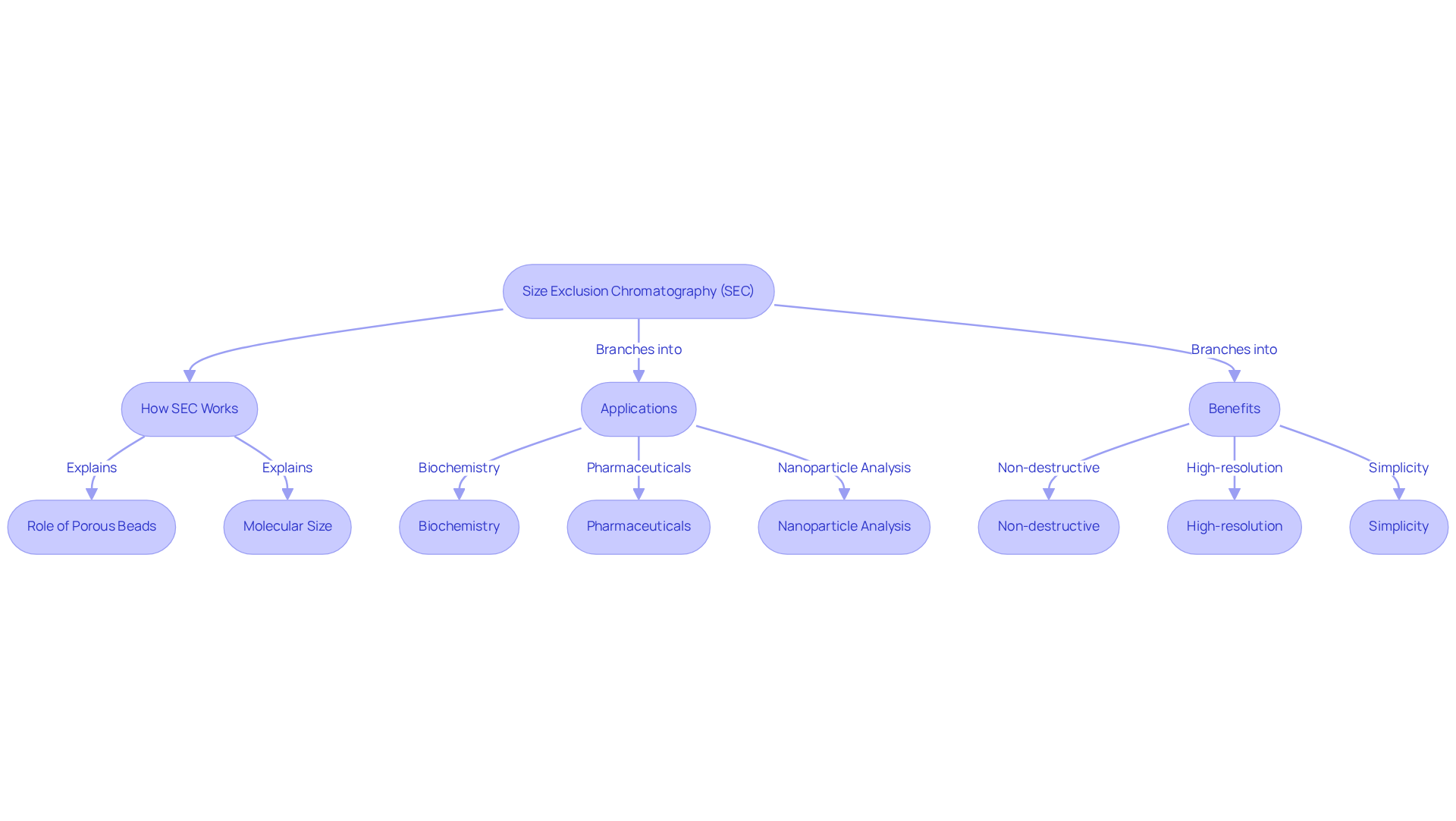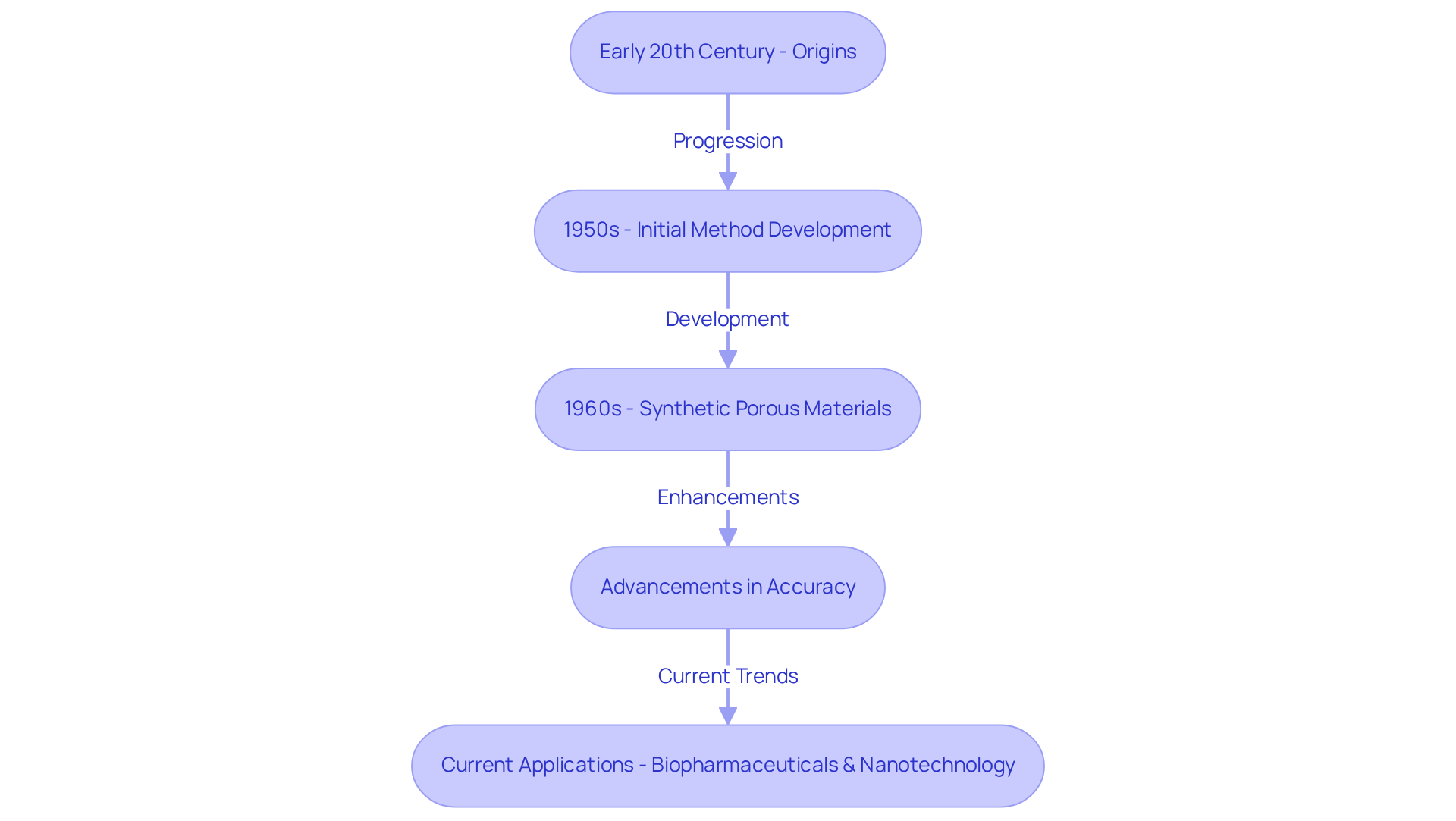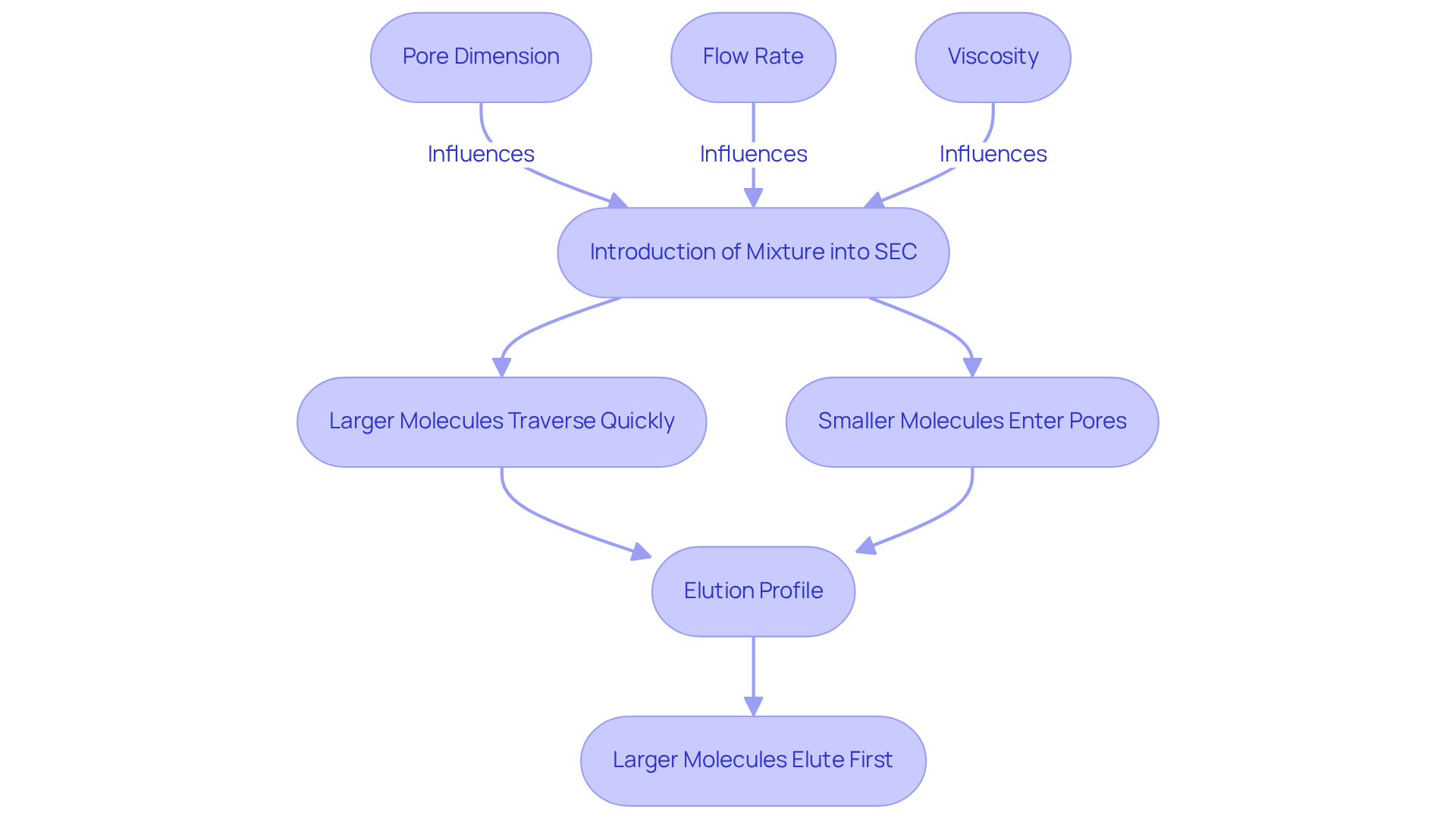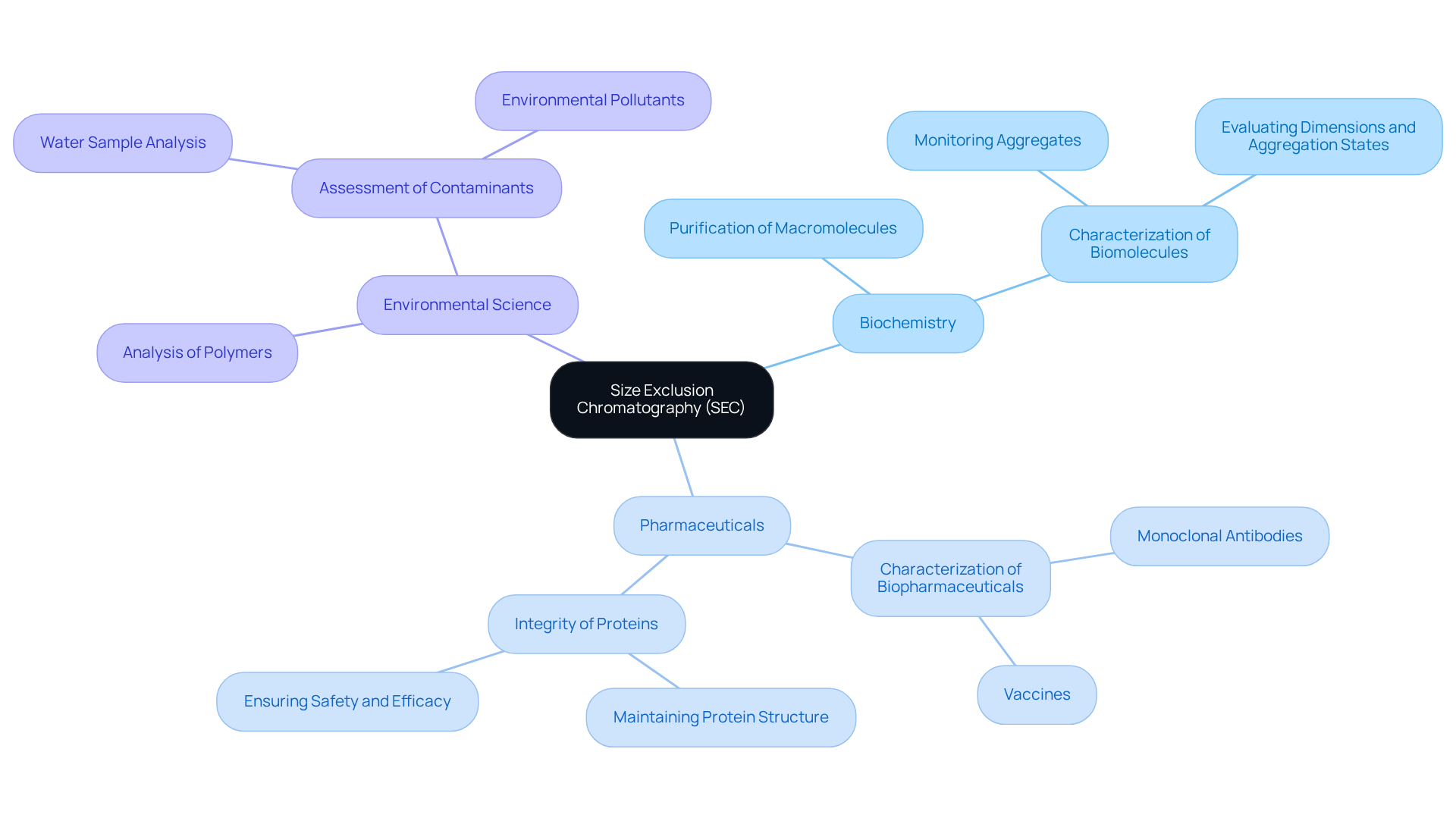Overview
Size exclusion chromatography (SEC) is a pivotal technique utilized to separate molecules based on their size. This method allows larger molecules to elute faster than smaller ones, as they cannot penetrate the porous beads within the column. The significance of SEC lies in its non-destructive nature and remarkable versatility, making it essential for various applications in biochemistry and pharmaceuticals.
It is particularly valuable for the purification and characterization of sensitive biological samples, such as monoclonal antibodies. Furthermore, SEC finds its application in environmental science, where it plays a crucial role in analyzing pollutants. The multifaceted utility of SEC underscores its importance in both scientific research and practical applications.
Introduction
Size exclusion chromatography (SEC) stands as a pivotal technique that transforms the separation of molecules based on size, playing an essential role in numerous scientific disciplines. By employing porous materials, SEC facilitates the rapid elution of larger molecules compared to their smaller counterparts, rendering it indispensable for applications in biochemistry and pharmaceuticals. This is particularly true in the purification and characterization of sensitive biological samples.
Yet, as researchers delve deeper into its potential, challenges emerge regarding its limitations and the difficulty of distinguishing between molecules of similar sizes.
What future advancements await this technique, and how can it evolve to meet the dynamic demands of scientific exploration?
Define Size Exclusion Chromatography and Its Importance
What is size exclusion chromatography, also known as gel filtration chromatography, and how is it a pivotal technique for separating molecules based on size? Developed in the 1950s, this method involves introducing a sample into a structure filled with porous beads. Larger molecules are excluded from entering the pores, allowing them to elute from the column more quickly than smaller molecules, which can penetrate the pores and take longer to traverse the column. This approach is crucial in many areas, particularly in biochemistry and pharmaceuticals, where understanding what is size exclusion chromatography facilitates the purification and examination of substances, polymers, and other macromolecules.
The significance of what is size exclusion chromatography (SEC) is highlighted by its ability to provide high-resolution separations without compromising the integrity of sensitive biological samples. This non-destructive characteristic makes it especially valuable for applications involving biological molecules, where preserving biological activity is essential. In the pharmaceutical sector, understanding what is size exclusion chromatography is critical for the characterization of therapeutic substances, including monoclonal antibodies and antibody-drug conjugates, ensuring that these biopharmaceuticals meet stringent quality standards.
What is size exclusion chromatography (SEC) in pharmaceuticals offers key benefits such as simplicity and versatility, requiring minimal sample preparation while providing reliable results. The technique known as what is size exclusion chromatography is widely utilized for evaluating aggregate formation, a vital factor in the effectiveness and safety of biotherapeutics. Furthermore, what is size exclusion chromatography (SEC) has seen modern advancements, such as the use of ultra-high-performance columns with dimensions of 150 x 4.6 mm packed with sub-3 µm particles, which have significantly reduced analysis times to between 4 and 8 minutes, thereby enhancing throughput in laboratory settings.
Current applications of SEC extend beyond protein purification; it is also employed in the analysis of nanoparticles and liposomes, which are essential in drug delivery research. The capability to distinguish and examine these colloidal systems according to dimensions is critical for formulating efficient therapeutic approaches. As the pharmaceutical landscape evolves, understanding what is size exclusion chromatography becomes increasingly important, solidifying its position as a cornerstone technique in both research and industry. However, it is important to recognize that SEC is limited to separation based on dimensions and may encounter challenges in differentiating between molecules of similar measurements. Additionally, SEC can be coupled with techniques like multi-angle light scattering (MALS) for enhanced molecular weight determination, further illustrating its versatility in the pharmaceutical field.

Trace the Historical Development of Size Exclusion Chromatography
The origins of exclusion chromatography can be traced back to the early 20th century, with significant advancements occurring in the 1950s and 1960s. Initially recognized as a method for separating macromolecules in solution, early implementations concentrated on gel filtration. The development of synthetic porous materials in the 1960s allowed for enhanced accuracy in controlling pore dimensions, which in turn improved the clarity of separations. Over the decades, what is size exclusion chromatography (SEC) has evolved into a standard method for characterizing proteins and polymers, with applications now extending into biopharmaceuticals and nanotechnology. Today, what is size exclusion chromatography is regarded as a fundamental technique in analytical chemistry, particularly for analyzing complex biological samples.

Explain the Principles and Mechanisms of Size Exclusion Chromatography
What is size exclusion chromatography, and how does it operate on the principle of differential permeation of molecules through a porous medium? When a mixture is introduced into the SEC apparatus, it illustrates what is size exclusion chromatography, where molecules are separated based on size. Larger molecules cannot pass through the pores of the stationary phase—typically composed of porous beads—allowing them to traverse the structure more swiftly. Conversely, smaller molecules can enter these pores, resulting in a delayed transit through the structure. In the context of what is size exclusion chromatography, this size-based separation yields a distinct elution profile, where larger molecules elute first, followed by their smaller counterparts.
What is size exclusion chromatography (SEC) and how its effectiveness is influenced by several critical factors:
- The pore dimension of the stationary phase, which generally ranges from 10 to 1000 nm depending on the support material.
- The flow rate of the mobile phase, commonly optimized around 3 mL/hr for enhanced resolution.
- The viscosity of the sample solution.
For instance, the pore size of silica-based SEC materials is frequently around 10-100 nm, whereas agarose-based structures can accommodate larger biomolecules with pore sizes of 100-1000 nm.
Moreover, the interstitial volume fraction in SEC is approximately 38%, significantly impacting the separation process. The typical calibration curve linear range for SEC spans roughly 10 kDa to 500 kDa, underscoring its applicability in analyzing a diverse array of molecular weights. Adjusting parameters such as flow rate and column length can further improve resolution, with longer columns generally yielding superior separation efficiency.
In biopharmaceuticals, what is size exclusion chromatography (SEC) has real-world applications that are prevalent, as it plays a vital role in analyzing aggregates, thus ensuring the safety and efficacy of biologic therapies. As noted by Ricker and Sandoval, decreasing flow rates can enhance resolution in SEC separations. However, it is essential to recognize the limitations of SEC, including its restricted resolution and sensitivity to sample preparation. By optimizing these mechanisms, laboratories can achieve reliable and reproducible results in their analyses. The historical context of SEC is also noteworthy, with the first work on this technique published in 1953 by Wheaton and Bauman, marking the inception of its evolution into a standard method for macromolecular separation.

Explore Applications of Size Exclusion Chromatography in Various Fields
What is size exclusion chromatography (SEC) as it stands as a pivotal technique across diverse fields, including biochemistry, pharmaceuticals, and environmental science? In biochemistry, understanding what is size exclusion chromatography (SEC) is essential for the purification of macromolecules and the evaluation of their dimensions and aggregation states—critical factors for understanding function and stability. This technique allows researchers to observe aggregates and quaternary structures, thereby enhancing the characterization of biomolecules.
In the pharmaceutical sector, understanding what is size exclusion chromatography is indispensable for the characterization of biopharmaceuticals, such as monoclonal antibodies and vaccines, ensuring their safety and efficacy. Its unique ability to separate molecules based on size without altering their structure is particularly beneficial for maintaining the integrity of sensitive proteins.
Furthermore, in environmental science, SEC is employed to analyze polymers and contaminants in water samples, facilitating the assessment of environmental pollutants. By delivering reliable separation and characterization, SEC significantly contributes to advancements in research and product development across these critical fields.

Conclusion
Size exclusion chromatography (SEC) is a cornerstone technique in the separation of molecules based on size, playing an indispensable role across various scientific fields, particularly in biochemistry and pharmaceuticals. Utilizing a column filled with porous beads, SEC facilitates the efficient elution of larger molecules while allowing smaller ones to enter the pores. This precise separation process not only preserves the integrity of sensitive samples but also underscores the technique's critical importance in scientific research.
The article elucidates several key aspects of SEC, encompassing its historical development, operational principles, and diverse applications. From its inception in the early 20th century to its current status as a standard method for analyzing complex biological samples, SEC has undergone significant evolution. Its non-destructive nature and capacity to deliver high-resolution separations render it invaluable for characterizing biopharmaceuticals, evaluating aggregate formation, and analyzing environmental contaminants.
Given its pivotal role, ongoing advancements in SEC technology, such as the development of ultra-high-performance columns, further augment its utility in both research and industry. As the landscape of pharmaceuticals and biochemistry continues to evolve, understanding and implementing size exclusion chromatography remains crucial for ensuring the safety, efficacy, and quality of therapeutic products. Embracing this technique not only facilitates scientific exploration but also paves the way for innovations that can profoundly impact health and environmental outcomes.




